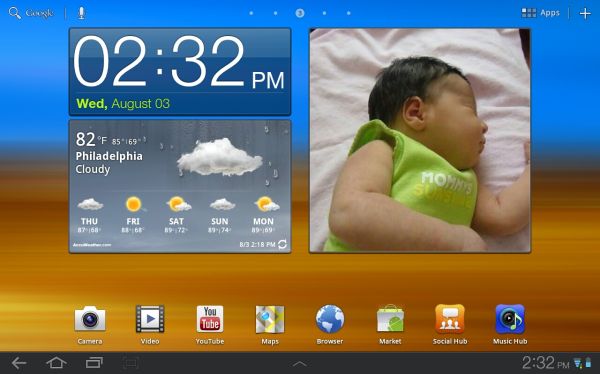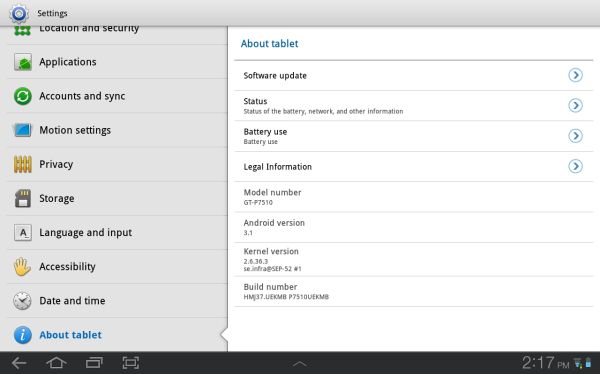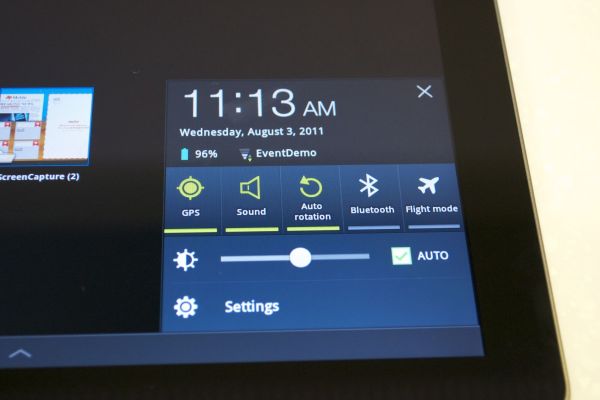Samsung TouchWiz UX Review: Honeycomb Gets Skinned
by Jason Inofuentes on August 5, 2011 11:52 AM ESTIt wasn’t long after the thinner, lighter, better Galaxy Tab 10.1 was announced that we heard Samsung would bring its TouchWiz skin to Android’s tablet OS, Honeycomb. After much debate over whether Honeycomb was truly ‘open,’ and not a closed iOS like environment, here we are. Starting today, Samsung Galaxy Tab 10.1 owners will start to see OTA updates pushed to their devices, offering the first skinned Honeycomb experience. We’ve got it now, and this is more than just a few widgets. Was it worth the wait, or will users avoid this optional update as long as they can?
Skins are Evil/Great
Let’s go over a few things that this update is not. This update is not Android 3.2; however, we did receive assurances that the heavy lifting for TouchWiz has already been done so there should be no delay in rolling out 3.2 and it’s graphics and UI enhancements. This update is not a cure for all the bugs that continue to ail Honeycomb; the occasional sluggishness and random Force Close events persist. This update is not a lag inducing crime against Android users; any enhancement that burdens the CPU or GPU at all will inherently result in some worsening lag, either in the UI or in opening, closing or using apps. But the lag we’ve seen is nothing too jarring, nor is it so far off from what’s normally found on Honeycomb. So, what is this update? Samsung described three key areas they wanted to enhance with what’s known now as TouchWiz UX; Ease of Use, Fun and Entertainment, Open for Business. By far, the most outward of these enhancements is Ease of Use, so we will start there.
Widgets and Apps
TouchWiz introduces three major enhancements, LivePanels, MiniApps and the Quick Panel. The last is the simplest of the lot and the easiest to dispense with; the same set of toggles we’ve seen stuffed into most skinned UI’s on Android is now present within the Notification shade, allowing users to manipulate all the devices radios, volume, screen brightness and vibrate functions with just a press. Hardly revolutionary but a good way to bring up some settings that were previously buried in menus.











![The Task Manager MiniApp alone on one homescreen [above], and then overlaid over another homescreen with populated widgets [below].](https://images.anandtech.com/doci/4582/Mini App Task manager and overlaid_575px.jpg)














30 Comments
View All Comments
JasonInofuentes - Friday, August 5, 2011 - link
Love it.Cleanskin - Friday, August 5, 2011 - link
"...now present within the Notification shade, allowing users to manipulate all the devices radios, volume, screen brightness and vibrate functions with just a press. Hardly revolutionary but a good way to bring up some settings that were previously buried in menus."Stock Android 3.1 already has most of these same settings available in the notification shade. Just tap on the system clock and they show up below.
JasonInofuentes - Friday, August 5, 2011 - link
So, yes, this was readily apparent when Samsung's Gavin Kim did a side by side comparison showing both the 3.1 shade and the modified shade. I do like this iteration better, though.SaigonK - Friday, August 5, 2011 - link
I would have been more impressed if Samsung woudl have gotten off their arse and gotten Netflix and Hulu deployed to the device...compared to my Ipad-2 the 10.1 is nice, but it isnt as refined and doesnt provide the media experience that i have become used to with my Ipad-2. No matter of UI enhancement is going to fix a clear lack of decent tablet based apps and a lack of media giants such as hulu and netflix...
vision33r - Sunday, August 7, 2011 - link
For any company to call themselves "enterprise ready.." they need to have a premier support division available 24/7 that any business can call free or charge to handle priority business needs. Microsoft and RIM both got this covered. I have yet to see anybody match up to their offering, not even Apple.As for this review, I got news for all the Android suffering vs iPad comparisons...
You ever look at the typical desktops of most people? It's got icons and shortcuts scattered over it, people don't organize their stuff or use App launchers anymore. They just go for the easiest thing to dump their icons on the desktop.
While Android allows for this too, it is not a clean and smooth experience when you have widgets blocking it and slowing down performance.
That's why Steve Jobs understands this simple reason and kept the iPad as basic and clean. It needs to operate like a book for average person to use it quickly for consumption.
Anytime I pickup WebOS, Playbook, and Honeycomb. It is utterly a huge fail for these companies to try to make things advance and turns to be huge learning curve for people. They don't need fancy widgets or cool multi-tasking app previews, that's for 1% of the population called geeks.
Belard - Monday, August 8, 2011 - link
Yep....By all means, I think WebOS is quite good. Its multi-tasking is easier than iOS 4.x (we'll see how iOS 5 improves when its officially released) - but it has some areas in which its more difficult than it should be.
I'm not happy with Apple's sue-happy mentality... it makes me want to by a lenovo ThinkPad tablet... I'm not happy with Samsung's Android support on their phones - so I'm NOT expecting anything better on their tablets - no matter how great they look.
But I'm not a fan of the 16x9 screens on Android tablets... And HP's Touchpad's hardware feels like the cheap plastic crap that it is. It feels cheap, it feels nasty once the back is covered with finger prints... I'll live with a few scratches on the back of an iPad - which is... ON THE BACK which I don't see - but do feel.
So with all this in mind... I think an iPad3 is more likely in my future than an Android tablet - even thou I hate and avoid using iTunes as much as possible.
fforblack - Monday, August 8, 2011 - link
Personally, I think that the best multitasking implementation is owned by WebOS. I like the cards idea...never really understood the stacks concept till I actually used one(found it a little bit useful actually)....But I didn't like how the touchpad denied us the gesture bar. I thought they would have done something like swipe right or left for next application or something. But whatever. When I saw this wasn't implemented, I got an iPad instead. I think I should have waited till now to make a choice, but whatever...I'm an apple developer, so I got gestures on my 2, and noticed the swipe left to right gesture. It offers to some degree a mini-version of what I wanted in WebOS's gesture area. If they could reduce the unfreezing latencies to about half of what it is now, I feel like gestures would make the iPad the coolest device I've ever seen(especially if you consider that the apps aren't really running in the background). If hp does something about this, the touchpad 2/3 might be my next tablet. Otherwise, I'm sticking with apple...